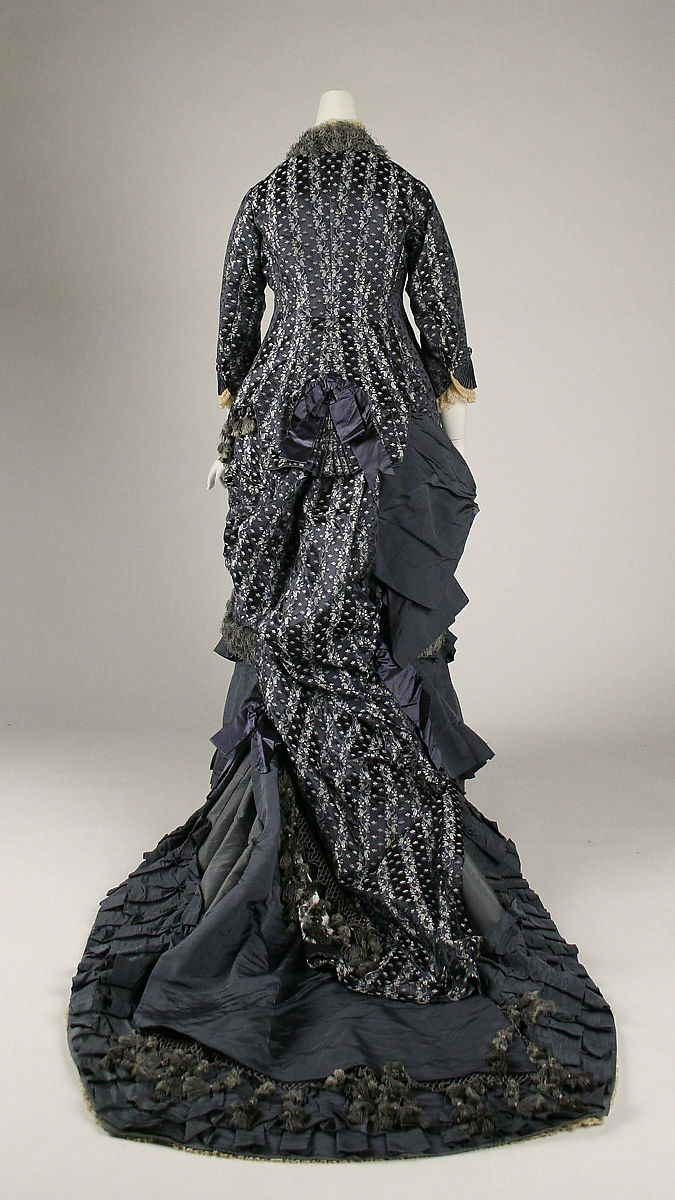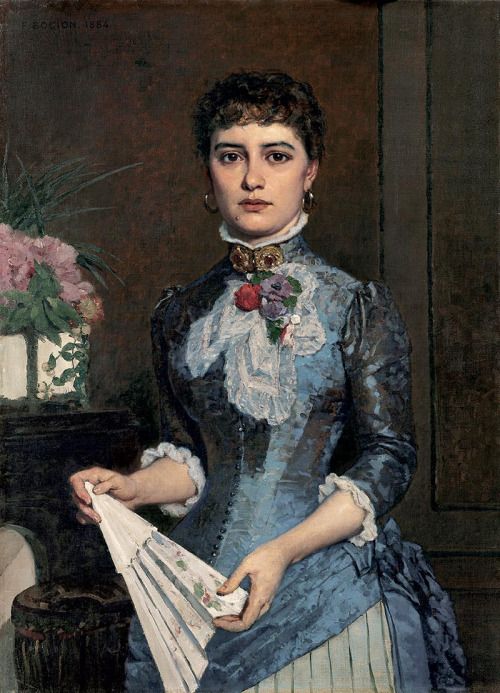The floral embroidered blue silk gown designed in the early 1880s had the design elements of tiered pleats, a bustle, chenille fringe and multiple embellishments which incorporated many different fashions of the time.
About the Look
This gown was designed by Amédée François in Paris during the early 1880s. This dress is made out of blue silk and covered with various lavish embellishments. The dress has a bustle and train, with a large blue silk bow at the rear (Fig. 1). There is also a large bow at the high collar of the dress. The blue silk brocade overskirt features a white and blue flower motif all over (Fig. 2). The train of the dress is composed of the same floral fabric and solid blue fabric that was seen on the underskirt. The buttons down the middle of the chest and on the cuffs (Fig. 2) feature an embroidered star motif. The cuffs of the dress have a pleated lace trim to match the collar of the bodice.
Gray chenille fringe is used as trim along the bottom of the overskirt portion of the gown and along the center front closure of the bodice. The skirt has three pleated layers that continue onto the train. On the bottom of the train and the edge of the bodice, there are gray tassels (Fig. 3). The dressmaker’s label can be seen in figure 4, including the Paris address of the dress shop.
Fig. 1 - Amédée François (French). Dress (back view), ca. 1880. New York: The Metropolitan Museum of Art, 43.72.2a–c. Source: The Met
Fig. 2 - Amédée François (French). Dress (cuff detail), ca. 1880. New York: The Metropolitan Museum of Art, 43.72.2a–c. Source: The Met
Fig. 3 - Amédée François (French). Dress (train detail), ca. 1880. New York: The Metropolitan Museum of Art, 43.72.2a–c. Source: The Met
Fig. 4 - Amédée François (French). Dress (label), ca. 1880. New York: The Metropolitan Museum of Art, 43.72.2a–c. Source: The Met
Amédée François (French), Dress, ca. 1880. Silk. New York: The Metropolitan Museum of Art , 43.72.2a–c. Source: The Met
About the context
This French dress, designed in the 1880s, follows the different trends at this time. The first reason that this gown was fashionable was the silhouette. The slim-fitting curaiss bodice paired with a bustle that leads into a train was very chic during the early 1880s and can be seen in multiple fashion plates and paintings.
The French fashion magazine Le Journal des modes included a plate in 1880 with similar narrow silhouette in blue floral brocade fabric, long train, tiered pleats and lace collar and cuffs (Fig. 5). This fashion plate like our gown takes different design elements that were trending in the beginning of the 1880s and incorporates them into one cohesive garment.
A similar pleated underskirt can be seen in French artist Albert Bartholomé’s In the Conservatory (Fig. 6). The gown worn by his wife in the painting is extant (Fig. 7), and is now in the collection of the Musée d’Orsay. The dress has pleated cuffs and a bow at the neck. The skirt below has two tiers of pleats. In 1884, François Bocion painted Jane Mercier (Fig. 8) in a blue gown with a pleated underskirt like our gown.
The March 12th, 1881 edition of Harper’s Bazar talks about the popularity of pleats being exposed by the overskirt opening up:
“Dress of dark blue spring Cheviot. Skirt trimmed with a rather deep flounce, with clusters of larger pleats separated at regular intervals…. the overskirt of the same material as the skirt, opened in fan shape.” (162)
The description written in Harper’s Bazar almost sounds like a description of our blue silk gown because of the striking similarities, including the overskirt opening into a fan-like shape and the evenly spaced large pleats. This American publication looked to Paris to see what was fashionable and the recognition of pleats being in style was just one influence from France.
La Mode illustrée was one of the most popular French fashion magazines of the late 1880s. Women of all social classes would turn to their La Mode illustrée to know what they should be wearing. The fashion plate of the March 26th, 1882 issue featured a taupe gown (Fig. 9) with many similarities to the blue silk gown. The bodice had buttons going down the front with matching trim flanking the center front closure. The overskirt opens to reveal the three tiered pleated underskirt.
In an article on fashion in the 1880s for the Fashion History Timeline, Harper Franklin explains that “a significant trend was the polonaise style, featuring a long bodice and an overskirt tucked up to reveal the underskirt, which was frequently ruffled or pleated” (Tortora 391). The revealing of the underskirt allowed women to also have their petticoats to be fashionable during this time.
The embellishments on the gown are another reason that this garment was fashionable for the early 1880s. In the painting A Private View at the Royal Academy, 1881 (Fig. 10) displays prominent people of the time including Ellen Terry (painted in aesthetic rather than fashionable dress). The artistic dress of Terry in green contrasts with the fashionable gown of the seated woman in the blue dress with pleated petticoat. Not only does this gown have tiered pleats, but is decorated in a similar manner to our blue silk dress with decorative trim flanking the center front buttoned bodice.
The final element of the gown that proves the designer was focused on emerging trends was the importance of gray chenille fringe. The bodice has this trim on either side of the buttons and it continues to trim the V-shaped opening of the overskirt. In Harper’s Bazar of November 1882, readers were instructed how to create chenille fringe for dresses (Fig. 11). An illustration is provided of “a close row of fine brown chenille strands, over which falls a row of single strands, each composed of three shaded brown chenille balls” (692). The detail image allows for dressmakers to know if they have correctly created this chenille fringe look.
Amédée François took inspirations from current 1880s trends to create this one-of-a-kind blue silk floral brocade gown with chenille fringe.
Fig. 5 - Artist unknown. Le Journal des modes, v. 51, plate 101 (1880). Casey Fashion Plates. Source: Tessa Digital Collections of the LA Public Library
Fig. 6 - Albert Bartholomé (French, 1848 - 1928). In the Conservatory, ca. 1881. Oil on canvas; 235 x 145 cm. Paris: Musée d’Orsay, RF 1990 26. Source: Musée d'Orsay
Fig. 7 - Designer unknown (French). Summer day dress worn by Madame Bartholomé in the painting In the Conservatory, ca. 1881. White cotton printed with purple dots and stripes. Paris: Musée d’Orsay. Gift of the Galerie Charles and André Bailly, 1991. Source: The Met
Fig. 8 - François Bocion (Swiss, 1828-1890). Portrait de Jane Mercier, 1884. Oil on canvas; 77 x 57 cm. Lausanne, Vaud, Switzerland: Fondation de l’Hermitage. Don du Dr Michel Bugnion, 2000. Source: Fondation de l’Hermitage
Fig. 9 - J. Bonnard (French). La Mode illustrée, March 26th, 1882. Tokyo: Bunka Gakuen Library, 13. Source: Bunka Gakuen Library
Fig. 10 - William Powell Frith (British, 1819-1909). A Private View at the Royal Academy, 1881 (detail), 1883. Oil on canvas; 60 x 114 cm. Private collection: Pope Family Trust. Source: Wikimedia Commons
Fig. 11 - Artist unknown. Harper's Bazar, November 1882. Source: The Harper's Bazaar Archive
References:
- “Chenille Fringes for Dresses, Wrappings, etc.” Harper’s Bazar, Nov 04, 1882, 692, https://libproxy.fitsuny.edu:2818/docview/1850146544?accountid=27253.
- “Chitchat for Fashions in February.“ Godey’s Magazine 104-105, no. 620 (February 1882): 182. https://babel.hathitrust.org/cgi/pt?id=umn.31951d00322066i&view=1up&seq=10.
- Franklin, Harper. “1880-1889.” Fashion History Timeline, October 11, 2019. https://fashionhistory.fitnyc.edu/1880-1889/.
- “Paris Fashions.“ Harper’s Bazar XIV, no. 11 (March 12, 1881): 162. https://books.google.com/books?id=t6z7-QiPaRIC&pg=PA251#v=onepage&q&f=false
- Tortora, Phyllis G. and Keith Eubank. Survey of Historic Costume, 5th ed. New York: Fairchild Books, 2010. http://www.worldcat.org/oclc/865480300.






















